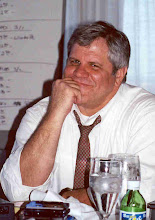
Sinbad, the penniless sailor of myth and legend, was held captive by the evil sorcerer-king. After a period of unspeakable torture, the king came to him with a riddle that would determine his ultimate fate.
"See, here." said the king. "I have a parchment with nine spots. Your life depends on how you use them. I want you to connect them all with as few lines as possible. The lines must be straight. And each line must touch another, as though a hand had made them all without leaving the page.
"If it takes you five lines or more," said the king, "I shall leave you in this living hell of daily torture. Four lines buys you a speedy and painless death. Three buys your freedom. And if you do the impossible, and use only two, you win my kingdom, the hand of my daughter, and I shall become your prisoner."
. . .
. . .
. . .
Sinbad pondered a moment, carefully folded the parchment several times, then stabbed it with a stick. "There, my Lord", said Sinbad. "Nine spots with a single line. And the price for it is your head." The king let out a fearful scream of disbelief, then realizing that his own riddle had doomed him, he ripped off his head with his bare hands and gave it to Sinbad before collapsing. Sinbad of course, took the daughter, the treasure and the kingdom and lived in sumptuous wealth to a ripe old age. Modification, you see, can be as creative and as useful as invention.
The Creative Eye
Creativity is how Sinbad got a head. As you can see, bad puns often hold great truths. The fact is that many folks spend their entire lives in the cave of torture, because they simply do not see the opportunities that sit in their laps. They deny themselves their own creativity by imposing even more constraints on themselves than the natural order or an evil king ever imagined, such as:
- the paper must remain flat,
- we can't diminish or increase the size of the dots,
- we have to use a standard size writing instrument,
- all the constraints are equally important, or
- we can't go outside the apparent boundaries.
The last one is a major cause of creative blindness. Take another look at the piece of parchment. When we first look at it, we imagine that the outer dots form a fence, and all our efforts must remain tortuously inside. But if we do that, 5 lines is the best we can do. It is only when we go outside that self imposed boundary that we arrive at the 4 line solution
That's creativity, literally going beyond the boundaries. And things get even more interesting when you try to do it with one line. As it turns out, Sinbad didn't have the only good solution. In fact, you may want to try your own before you proceed. Now here's a word to the wise. If that doesn’t do it for you, well --- you know, if it were me I’d give up on logical solutions. I’d get frustrated and start doing stupid stuff. Give it a try. It might be good therapy
Now, let’s take a look at some solutions.
Solution A - change the environment. Go to a copier and set it on "reduce". Then keep re-running the parchment until the 9 dots essentially merge into 1 dot. Then your #2 Ticonderoga will "connect" them in 1 line. Or get a gigantic magic marker. The net effect is the same.
Solution B - go a step further. In addition to changing the size of the dots (this time making them gigantic), also change the contour of the page – roll it into a cylinder. Once you've done those two things, one line will circle the tube and go through all 9 dots, if you pick the right angle --- like a descending staircase.
Solution C - is the effectiveness solution. If the core task (connecting the dots with 1 line) is important enough, violating one or more of the constraints may be the proper solution. We simply remove a constraint and use a curved line. Let is snake its way through all 9 dots. Pretty simple, and effective.
© 2009 Joe Anderson



